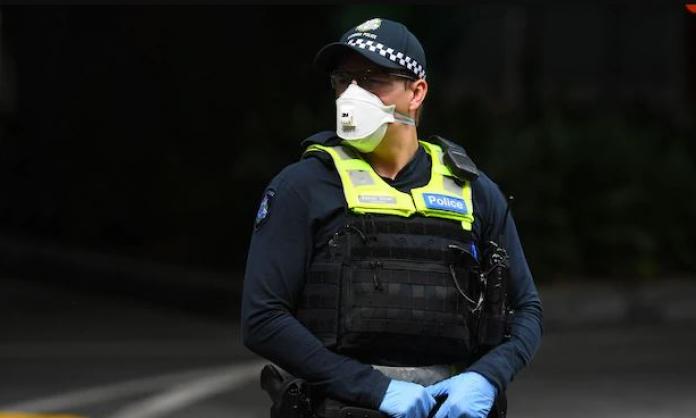There will be no sharp “snapback” from this crisis. The speed of the economic collapse has been even greater than that of the spread of the coronavirus. It is totally unprecedented in the history of capitalism.
The US economy, for example, shrank by a quarter in just three months. It’s a similar amount to the contraction in the Great Depression of the 1930s – but that occurred over a four-year period. The number of jobless in the US jumped by 6.6 million in the last week of March. A total of 16.8 million US workers have been made jobless in just three weeks. This rate of increase in unemployment is also unprecedented. Economists, including those from the US Federal Reserve, estimate that by the end of the northern summer, 30 percent of the US working class will be out of work.
Various capitalist propagandists are trying to spin the line that this rapid economic collapse will be followed by an equally rapid recovery in the second half of this year: that we will have a so-called V-shaped recession (the quick drop being followed by a speedy recovery) and then capitalism will return to “normal”.
We are living in an incredibly volatile period. No one can know for sure exactly how catastrophic the economic and social crisis will be, how long it will continue, how many workers will lose their jobs, how many people will be made homeless or starve to death. However, any idea that this crisis is going to be resolved and workers will all be returning to their jobs in six or nine months is sheer fantasy. The new “normal” will be ongoing crisis and relentless attacks on working class living standards to restore the profits of big business.
In part, the scale of the economic crisis will depend on the severity and longevity of the pandemic. Will the virus keep coming back in wave after wave like the 1918-19 influenza pandemic? Governments that rush to lift the current lockdown under pressure from capitalists concerned about profits will simply reignite the pandemic and ensure there are many more needless deaths and even greater economic turmoil.
However, the economic collapse is not simply a product of the virus. While the pandemic undoubtedly sparked the downturn, it was a recession waiting to happen. The recovery of the world economy from the 2008 global financial crisis was anaemic. Growth rates remain suppressed because the rate of profit never recovered sufficiently to ensure a sustained increase in investment in productive industries.
Instead, huge sums of money flowed into speculative investments in the financial sector, combined with a surge of corporate debt as central banks all around the world slashed interest rates and flooded the financial markets with liquidity to keep the stagnant economy afloat.
Signs of a renewed recession have been mounting for the last 18 months. Various European banks have come under severe pressure. The German economy, the world’s fourth largest, stagnated last year. The Japanese economy, the world’s third largest, moved into recession before the pandemic hit. The Bank of France is projecting a 6 percent contraction in that country for the first three months of this year. The Italian, Spanish, Turkish and various other economies were also under pressure. And Chinese growth rates had already slowed.
Growing corporate debt over the last decade, often in so-called zombie companies that produce nothing, has sharply increased the vulnerability of the world economy to any downturn or shock. It has led the US Federal Reserve to pour trillions of dollars into the economy to stave off an escalating wave of bankruptcies of large and medium-sized businesses. In an unprecedented action, it is even buying up so-called junk bonds – poor quality corporate debt instruments, many of which are due to be paid back. Many companies simply don’t have the money and are now facing bankruptcy. And it isn’t just second tier players in the business world that are under threat of bankruptcy. Ford, for example, has US$36 billion in junk bonds about to come due.
Adding to all this, 73 percent of US households reported a loss of income in March. This will intensify the downturn and lead to a further contraction in business investment. The Federal Reserve, with the approval of Wall Street and the core sections of the US business class, has in effect taken over management of the US economy because the Trump administration is recognised as totally incompetent.
But it is not just the US. World trade has collapsed even more sharply than national production. The World Trade Organization projects that world merchandise exports, which had already declined by 3 percent in US dollar terms in 2019, will decline by between 13 and 32 percent this year – considerably more than in the aftermath of the 2008 Global Financial Crisis.
The German economy is expected to contract even more than the US because of its dependence on the export of machinery, cars and other manufactured goods. The car market has been wiped out. Petrol consumption is down 88 percent in Europe. Japan is likely to be even harder hit than Germany.
The scale of the collapse has been an absolute game changer. There will be no return to “normal” in the next six months. We see that in China, where, after months of lockdown and incredible disruption to the economy, the state is trying to get things up and running again. That is much easier said than done.
The government can reopen the big factories, but the collapse of world trade means that there is no market for many of the goods that Chinese factories produce, and the collapse in incomes and the high levels of unemployment have hit the domestic market. Furthermore, a whole series of small businesses that employ millions of workers have simply gone to the wall and will not reopen.
And any attempt to get back to “normal” also risks leading to a resurgence of the virus. The Chinese authorities have to restrict tourism, which impacts hotels, gambling and other industries. And it is not just tourism. Reopening cinemas, for example, is a risky proposition in terms of the spread of the virus. The Chinese government tentatively allowed a few hundred out of more than 70,000 cinemas to reopen, but then quickly had to shut them down again. The same problem applies to a series of other service industries – entertainment venues, sporting and cultural events, restaurants and so on. And services account for well over half of the Chinese economy.
Then there is the question of social unrest – the potential for upheavals. There have already been protests by migrant workers returning from Hubei province. These problems of trying to contain the situation when governments begin to lift restrictions are going to be even more difficult for governments to deal with in countries that don’t have an authoritarian state apparatus on anything like the scale of China.
According to a recent UN report, the pandemic will push half a billion people into poverty. It assumes that consumption will contract 20 percent in the Global South – almost certainly an underestimate. This will lead to a huge number of deaths, on top of those who die directly from the virus, and an incredibly volatile political situation. The turmoil will last for years.
The fact that Australia escaped many of the worst effects of the 2008 economic crisis, and that so far the death toll here from the coronavirus has been nowhere near as severe as in the US or Europe, has led various commentators and politicians to predict that the Australian economy can come out of this relatively unscathed. That is extremely unlikely.
Australia’s dependence on commodity exports – coal, iron ore, liquefied natural gas – means the local economy will be severely impacted by the contraction in world trade. Already we have seen the collapse of the tourist industry, which hits airlines, hotels, entertainment venues, retailers and so on. The universities have been savaged by the collapse of their major revenue stream, international students. The government’s bailout packages will not get airlines flying again, lead to international students returning any time soon or lead to a revival in world trade.
The growth rate of the Australian economy since 2008 has also been sluggish. To the extent that it has held up at all it has largely been due to high levels of immigration. Australia is quite peculiar, compared to most other advanced capitalist economies, in its dependence on immigration to underpin its economy. Migration has now dried up and will not resume at high levels anytime soon. This will severely hit a series of industries.
One of the worst impacted will be construction, which is a larger share of the Australian economy than of most advanced economies and employs better paid workers. The collapse of immigration, international student numbers and tourism will result in a sharp contraction in the building of high-rise apartments, hotels, houses and shopping malls.
A severe contraction in the construction sector will flow on to other industries: furniture, household appliances, real estate agents and so on. Morrison’s bailout packages will, at best, only soften this a bit.
Then there is the question of how long the government is prepared to maintain the JobKeeper package and the doubling of the dole. Morrison is saying it will be for six months – but that will be nowhere near enough to get the economy back on its feet. Yet the packages have already led to an explosion of government debt. To extend them for another six months or a year would raise the debt to astronomical levels. Government debt at that level will terrify the financial markets.
And in the longer term, the capitalist class will be out to ensure that it doesn’t have to cop the bill for the debt. On the one hand, it will continue to demand billion-dollar bailout packages from the government out of our taxes. On the other hand, it will try to make workers pay by cutting wages, undermining working conditions, cutting social services and raising consumption taxes such as the GST.
This will mean years of austerity, poverty and high levels of unemployment unless our side is galvanised in a massive, no holds barred fightback.









